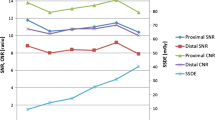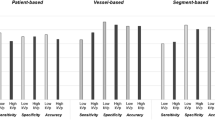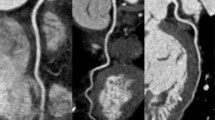Abstract
The purpose of this study was to investigate the effect of low kilovoltage dual-source computed tomography coronary angiography (CTCA) on qualitative and quantitative image quality parameters and radiation dose. Dual-source CTCA with retrospective ECG gating was performed in 80 consecutive patients of normal weight. Forty were examined with a standard protocol (120 kV/330mAs), 20 were examined at 100 kV/330mAs, and 20 at 100 kV/220mAs. Two blinded observers independently assessed image quality of each coronary segment and measured the image parameters noise, attenuation, and contrast-to-noise ratio (CNR). The effective radiation dose was calculated using CT dose volume index and the dose-length product. Diagnostic image quality was obtained in 99% of all coronary segments (1,127/1,140) without significant differences among the protocols. Image noise, attenuation, and CNR were significantly higher for 100 kV/330mAs (26 ± 3 HU, 549 ± 62 HU, 25.5 ± 3.2; each P < 0.01) and 100 kV/220mAs (27 ± 2 HU, 560 ± 43 HU, 25.0 ± 2.2; each P < 0.01) when compared to the 120-kV protocol (21 ± 2 HU, 317 ± 28 HU, 20.6 ± 1.7). There was no significant difference between the two 100-kV protocols. Estimated effective radiation dose of the 120-kV protocol (8.9 ± 1.2 mSv) was significantly higher than the 100 kV/330mAs (6.7 ± 0.8 mSv, P < 0.01) or 100 kV/220mAs (4.4 ± 0.6 mSv, P < 0.001) protocols. Dual-source CTCA with 100 kV is feasible in patients of normal weight, results in a diagnostic image quality with a higher CNR, and at the same time significantly reduces the radiation dose.


Similar content being viewed by others
References
Leschka S, Alkadhi H, Plass A et al (2005) Accuracy of MSCT coronary angiography with 64-slice technology: first experience. Eur Heart J 26:1482–1487
Mollet NR, Cademartiri F, van Mieghem CA et al (2005) High-resolution spiral computed tomography coronary angiography in patients referred for diagnostic conventional coronary angiography. Circulation 112:2318–2323
Raff GL, Gallagher MJ, O’Neill WW, Goldstein JA (2005) Diagnostic accuracy of noninvasive coronary angiography using 64-slice spiral computed tomography. J Am Coll Cardiol 46:552–557
Scheffel H, Alkadhi H, Plass A et al (2006) Accuracy of dual-source CT coronary angiography: first experience in a high pre-test probability population without heart rate control. Eur Radiol 16:2739–2747
Flohr TG, McCollough CH, Bruder H et al (2006) First performance evaluation of a dual-source CT (DSCT) system. Eur Radiol 16:256–268
Leber AW, Johnson T, Becker A et al (2007) Diagnostic accuracy of dual-source multi-slice CT-coronary angiography in patients with an intermediate pretest likelihood for coronary artery disease. Eur Heart J. 28(19):2354–2360
Matt D, Scheffel H, Leschka S et al (2007) Dual-source CT coronary angiography: image quality, mean heart rate, and heart rate variability. AJR Am J Roentgenol 189:567–573
Hausleiter J, Meyer T, Hadamitzky M et al (2006) Radiation dose estimates from cardiac multislice computed tomography in daily practice: impact of different scanning protocols on effective dose estimates. Circulation 113:1305–1310
Stolzmann S, Scheffel H, Schertler T et al (2008) Radiation dose estimates in dual-source computed tomography coronary angiography. Eur Radiol. 18(3):592–599
Huda W, Scalzetti EM, Levin G (2000) Technique factors and image quality as functions of patient weight at abdominal CT. Radiology 217:430–435
Budoff MJ, Achenbach S, Blumenthal RS et al (2006) Assessment of coronary artery disease by cardiac computed tomography: a scientific statement from the American Heart Association Committee on Cardiovascular Imaging and Intervention, Council on Cardiovascular Radiology and Intervention, and Committee on Cardiac Imaging, Council on Clinical Cardiology. Circulation 114:1761–1791
Leschka S, Scheffel H, Desbiolles L et al (2007) Image quality and reconstruction intervals of dual-source CT coronary angiography: recommendations for ECG pulsing windowing. Invest Radiol 42:543–549
Austen WG, Edwards JE, Frye RL et al (1975) A reporting system on patients evaluated for coronary artery disease. Report of the Ad Hoc Committee for Grading of Coronary Artery Disease, Council on Cardiovascular Surgery, American Heart Association. Circulation 51:5–40
Husmann L, Alkadhi H, Boehm T et al (2006) Influence of cardiac hemodynamic parameters on coronary artery opacification with 64-slice computed tomography. Eur Radiol 16:1111–1116
Lembcke A, Wiese TH, Schnorr J et al (2004) Image quality of noninvasive coronary angiography using multislice spiral computed tomography and electron-beam computed tomography: intraindividual comparison in an animal model. Invest Radiol 39:357–364
McCollough CH, Primak AN, Saba O et al (2007) Dose performance of a 64-channel dual-source CT scanner. Radiology 243:775–784
Menzel H, Schibilla H, Teunen D (eds) (2000) European guidelines on quality criteria for computed tomography. European Commission publication no. EUR 16262 EN. European Commission, Luxembourg
Gerber TC, Kuzo RS, Morin RL (2005) Techniques and parameters for estimating radiation exposure and dose in cardiac computed tomography. Int J Cardiovasc Imaging 21:165–176
McNitt-Gray MF (2002) AAPM/RSNA physics tutorial for residents: topics in CT. Radiation dose in CT. Radiographics 22:1541–1553
Landis JR, Koch GG (1977) The measurement of observer agreement for categorical data. Biometrics 33:159–174
Leschka S, Husmann L, Desbiolles LM et al (2006) Optimal image reconstruction intervals for non-invasive coronary angiography with 64-slice CT. Eur Radiol 16:1964–1972
Wintersperger BJ, Nikolaou K, von Ziegler F et al (2006) Image quality, motion artifacts, and reconstruction timing of 64-slice coronary computed tomography angiography with 0.33-second rotation speed. Invest Radiol 41:436–442
Ferencik M, Nomura CH, Maurovich-Horvat P et al (2006) Quantitative parameters of image quality in 64-slice computed tomography angiography of the coronary arteries. Eur J Radiol 57:373–379
Pannu HK, Jacobs JE, Lai S, Fishman EK (2006) Coronary CT angiography with 64-MDCT: assessment of vessel visibility. AJR Am J Roentgenol 187:119–126
Deetjen A, Mollmann S, Conradi G et al (2007) Use of automatic exposure control in multislice computed tomography of the coronaries: comparison of 16-slice and 64-slice scanner data with conventional coronary angiography. Heart 93:1040–1043
Nakayama Y, Awai K, Funama Y et al (2005) Abdominal CT with low tube voltage: preliminary observations about radiation dose, contrast enhancement, image quality, and noise. Radiology 237:945–951
Boone JM, Geraghty EM, Seibert JA, Wootton-Gorges SL (2003) Dose reduction in pediatric CT: a rational approach. Radiology 228:352–360
Brooks RA (1977) A quantitative theory of the Hounsfield unit and its application to dual energy scanning. J Comput Assist Tomogr 1:487–493
Sigal-Cinqualbre AB, Hennequin R, Abada HT, Chen X, Paul JF (2004) Low-kilovoltage multi-detector row chest CT in adults: feasibility and effect on image quality and iodine dose. Radiology 231:169–174
Abada HT, Larchez C, Daoud B, Sigal-Cinqualbre A, Paul JF (2006) MDCT of the coronary arteries: feasibility of low-dose CT with ECG-pulsed tube current modulation to reduce radiation dose. AJR Am J Roentgenol 186:S387–S390
Mulkens TH, Bellinck P, Baeyaert M et al (2005) Use of an automatic exposure control mechanism for dose optimization in multi-detector row CT examinations: clinical evaluation. Radiology 237:213–223
Vehmas T, Kivisaari L, Huuskonen MS, Jaakkola MS (2005) Scoring CT/HRCT findings among asbestos-exposed workers: effects of patient’s age, body mass index and common laboratory test results. Eur Radiol 15:213–219
Acknowledgements
This research has been supported by the National Center of Competence in Research, Computer Aided and Image Guided Medical Interventions of the Swiss National Science Foundation.
Author information
Authors and Affiliations
Corresponding author
Rights and permissions
About this article
Cite this article
Leschka, S., Stolzmann, P., Schmid, F.T. et al. Low kilovoltage cardiac dual-source CT: attenuation, noise, and radiation dose. Eur Radiol 18, 1809–1817 (2008). https://doi.org/10.1007/s00330-008-0966-1
Received:
Revised:
Accepted:
Published:
Issue Date:
DOI: https://doi.org/10.1007/s00330-008-0966-1




